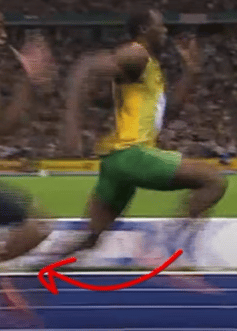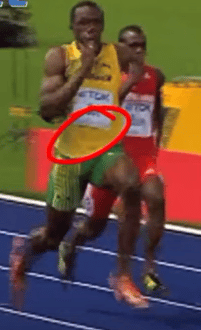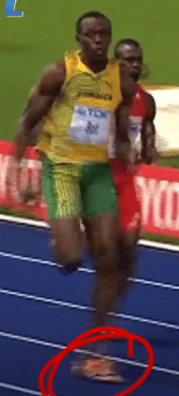How to Apply More Force to the Ground When Sprinting? (5 Tips)
Jun 11, 2022
If you are a sprinter, you have probably read a lot about how force production is critical when sprinting. So if you are looking to understand HOW to apply more force to the ground when sprinting, you have come to the right place. At the end of the day, when you are sprinting, each individual step is important, so you have to know how to get the most out of every single leg cycle in order to reach your full potential as an athlete and sprinter.
In this post, we’ll discuss the 5 main parts of your sprinting mechanics that’ll help you put the maximum force down into the ground. Since the best way to understand something is to learn it from the best in the business, we’ll do the same. There’s no sprinter out there who is able to apply more force to the ground than Usain Bolt.
Let’s have a look at the 5 musts to maximize the force into the ground when sprinting.
1. Vertical & Horizontal Force
It’s important to know that horizontal force is also vital when it comes to sprinting mechanics. So, when we talk about generating force into the ground, we’ll take both the horizontal and the vertical forces into account.
If you observe Usain Bolt’s run more closely, you can see that he gets height as he is pushing off the ground which allows him to generate vertical force. He also does a great job of getting all the way up onto his big toe to really maximize every inch of his foot which is like the wrist flick as a quarterback.
The better you can utilize your toes when pushing off the more vertical and horizontal force you will be able to generate. Since he gets so much height when pushing off he has plenty of time to cycle his foot out in front and more importantly pull the leg underneath to generate horizontal force as well as a vertical force during foot contact which is when the most amount of force is generated into the ground.

2. Full Range of Motion within Legs
There is two important range of motion limitations we see in sprinters or athletes looking to get faster. The first one is limited knee height and the second one is an inability to extend the leg as it’s coming through.
When you observe Usain Bolt, you’ll see that he brings his foot up to his butt while still achieving great hip flexion (knee even with the hip). Additionally, he is able to fully extend his leg in front of him before foot contact which allows him to engage his full hamstring and glute muscle.

Also check out: What Is Turnover Speed? An Analysis
3. Pulling Leg Back and Down
This allows you to create more vertical and horizontal force when you are sprinting. You should be able to achieve maximum force (Newtons) production. If you roughly calculate these forces, guys like Usain Bolt create over 4000 Newtons of force IN EACH STEP.
Now, most of those Newtons of force come from his vertical force production so the goal would be to generate around 3000 Newtons vertically and the remaining should be a horizontal force. Just to give you an idea that is over 900 pounds of force on each leg but it should also show you how important force production is when sprinting.
People often make the mistake of landing with their front leg too far in front of them and that limits their ability to put force into the ground. As a sprinter, how you land is critical to your performance and where you land will allow you to optimize each step to maximize speed.
4. Necessary Strength for Lower Body
The lower core (transverse abdominis) is vital for strength and force production. It helps you stabilize your hips and allows you to generate more force. You also need to be strong within your quads, hamstrings, and ankles.
Overall, a strong lower half of your body will significantly contribute towards generating more force to the ground. It doesn’t mean you can compromise on your upper body. The upper body is important for balance and maintaining an excellent center of mass. However, you will not be able to accelerate what you cannot decelerate so in order to run faster you must be able to control slowing down better.

5. Stabilization
When your foot hits the ground, you can’t have any extra movements (action). The focus should be to land with your knee slightly bent and transition throughout the landing phase without spending a lot of time bending your knee. A big part of stabilization is to absorb the force when landing your foot on the ground.
All five things explained above are critical to applying maximum force to the ground. You have to be able to generate and control the force. You might not be able to do it during the first few attempts, but as you practice more, you’ll be able to master these movements and increase your overall speed.

Quick Recap:
Let’s have a quick recap of what we’ve learned so far about how to apply more force to the ground when sprinting:
- Being able to get a vertical push off
- Having full range of motion within your legs
- Pulling your leg back and down
- Power and strength within your lower body
- Control and stabilize your lower
Read more: Top 10 Secrets To Improve Speed Immediately | Spring Mechanics
Final words
This was all about how to apply more force to the ground when sprinting, if you liked the information presented here, feel free to check our official website to know more about specific programs we offer to help you run faster.
If you have any questions, comments, or recommendations, you can leave those down below in the comments section, we’ll be happy to get back to you as soon as we can. We look forward to hearing from you.
About Author
Stay connected with news and updates!
Join our mailing list to receive the latest news and updates from our team.
Don't worry, your information will not be shared.
We hate SPAM. We will never sell your information, for any reason.

